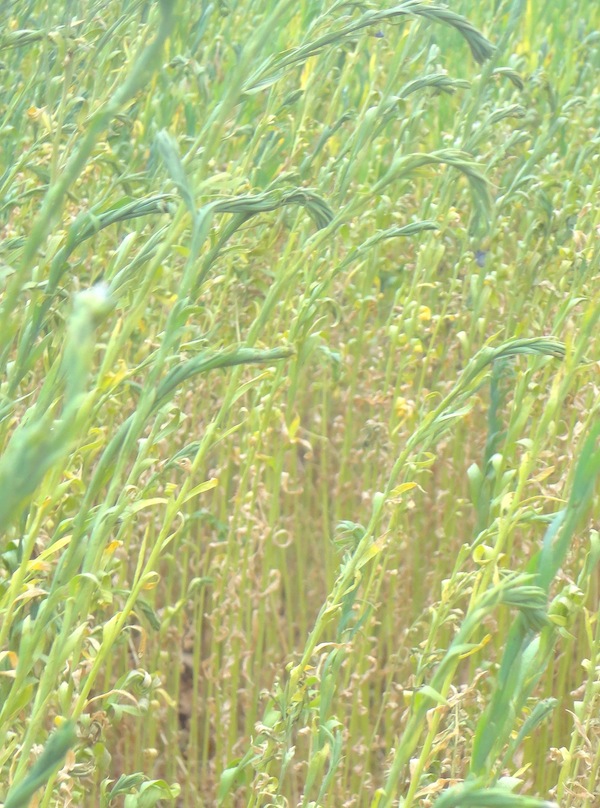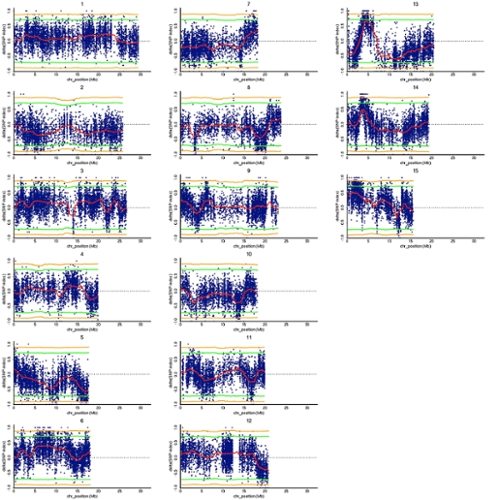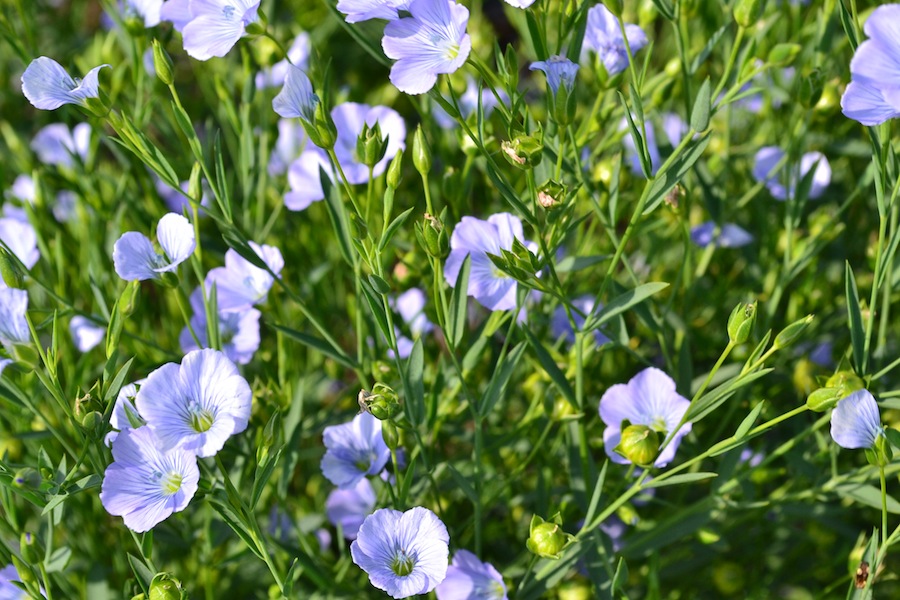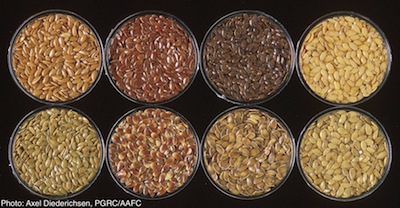Current Research Projects
Disease Resistance
We are identifying and characterizing genes that provide flax with resistance to pasmo, powdery mildew, fusarium wilt and rust. These four diseases are prevelant across the Canadian Praries and can result in significant yield losses.

Fusarium wilt in flax
Characterizing Rust Resistance Genes in Flax
This project will provide detailed information about the genes responsible for flax resistance to rust. The current flax cultivars in North America possess at least two R genes. The pyramiding of R genes is challenging for breeding programs when screening is done at a phenotypic level because allelic identification requires repeated inoculation with individual races followed by visual scoring of infection rate and type. Biosafety equipment and procedures also need to be in place when using non-endemic rust races. Genomic DNA extraction and the use of multiple markers are considerably less labor-intensive and time-consuming, and hence are cheaper and more efficient. A number of bioinformatics resources have been used to analyze the genomic organization of four known rust resistance genes (L, M, N, and P loci) (S. Ravichandran, F.M. You, K.Y. Rashid, L. Young, H.M. Booker, S. Cloutier, 2017. Structural organization and haplotypes of rust resistance genes in flax. Joint Meeting Canadian Phytopathological Society and Canadian Society of Agronomy, Winnipeg, June 18-22, P3).
QTL-Seq pipeline to map disease resistance loci in flax
A bioinformatics “pipeline” called QTLseq was used to identify putative resistance loci for powdery mildew (PM) and fusarium wilt (FW). Two inbred populations (Aurore × Adelie (AA) and Aurore × Oliver (AO)) were segregating for PM (AA and AO) and FW (AO only) resistance and provided information about the susceptibility of each of the lines within these two populations to PM and FW (each line in both populations had been “resequenced” using Next Generation Sequencing (NGS) technology). Together, this information was used to select a subset of individuals in the population to study and use in the QTLseq pipeline. Four loci that putatively provide resistance to Canadian strains of powdery mildew were identified (L.W. Young. J.P. Trouve, A. Speck, F. You, S. Robinson, K. Rashid, and H. Booker, 2017. Using QTLseq to identify powdery mildew resistance loci in flax. 2nd International Symposium on Innovations in Plant and Food Science, University of Saskatchewan, Saskatoon, SK, 10 Sept). It was more difficult to identify loci providing resistance to FW as multiple genes, each with a small effect, are responsible for this trait. Using QTLseq on the AO population, we identified a putative locus associated with FW resistance on LG5. The QTLseq pipeline could be updated with more recent software; this would make the pipeline easier and faster to use and might increase its accuracy. Additionally, we gained a better appreciation of the amount of NGS data required for successful operation of the pipeline.
Fusarium wilt and pasmo resistance
We are working with collaborators in the University of Saskatchewan (Dr. Randy Kutcher) and at Agriculture and AgriFood Canada to identify factors involved with resistance to fusarium wilt and pasmo. These two diseases are the most probelmatic pathogens for Canadian flax producers. We are screening populations to identify lines with ressitance to these diseases and will develop mapping populations to better understand the genetics of resistance. Molecular markers and bioinformatics analysis will be used to identify chromosomal regions or genes associated with resistance to these diseases. This information will be used to breed cultivars with improved disease resistance and increase our understanding of pathogen resistance mechanisms.

Developing flax adapted to the Northern Prairies
The short growing season experienced in the northern region of the flax production area can limit the production of current flax cultivars. The Flax Breeding Program is actively developing cultivars that are better adapted for the northern parts of the flax growing area.
Characterization of Flax Breeding Lines for Northern Adaptation and Stability of Yield and Maturity
Producers value ratings for issues such as consistent and predictable maturity and consistency of yield (pers. comm., Eric Fridfinnson, Past Chair, Prairie Reccommending Committee on Oilseeds and Chair, ManFlax). Presently, the statistical analysis for national performance test data utilizes a generalized linear model (GLM) implemented using Agrobase software. Traditional GLM assumes fixed effects and homogeneity of variance. Entries (genotypes) in regional testing as well as trial locations change from year to year. Experimental data from regional tests are thus often unbalanced across multi-environments with random and fixed effects coexisting, and so homogeneity of variance is not guaranteed. The mixed model method is superior to GLM for estimating genotype effects and interaction effects of genotype by environment (G × E) when dealing with a complicated data structure. Jia and Booker (2018) have identified optimal models using the 10-year post-registration dataset for the Saskatchewan Variety Performance Group (SVPG) trial yield data for flax.
Jia, G., and H.M Booker (2018) Optimal models for the yield analysis of flax cultivars. Canadian Journal of Plant Science 98(4): 897-907
Early flowering flax
Currently flax is not grown much at latitudes higher than Saskatoon (52.1°N) as the growing season is too short. We are developing Northern Adapted Flax that requires fewer days to flower and mature. Earlier flowering flax typically matures earlier and so is better suited for the more northern parts of the grainbelt. Two sources of variation (early flowering accessions from the World Core Collection and 5-azacytidine mutagenized CDC varieties) are being developed and assessed for their adaptation to Northern latitudes. We are also using molecular and genomic approaches to understand the mechanisms that induce earlier flowering in these lines.

Previous Research Projects
Seed coat color
Seed coat colour requires the expression of at least five different genes. We are developing molecular markers to gain a better understanding of the function of the genes involved in seed coat colour. This project was funded by Saskatchewan Ministry of Agriculture through the Agriculture Development Fund. Three of the genes required for seed coat colour have been identified and clues to the identity of a fourth discovered. We are also using molecular markers to map the location of the other gene.

Genome Prairie TUFGEN project (2009-2014)
The Crop Development Centre Flax Program was an important partner in Genome Prairie's Total Utilization Flax GENomics (TUFGEN) project. Dr. Gordon Rowland (CDC) and Dr. Sylvie Cloutier (AAFC) were the Co-Leads of this project, which aimed to characterize the genome of flax. CDC Bethune was used as reference variety for the whole genome sequencing of flax. The reference genome has already been used to develop a genetic map (using SNP and EST-SSR markers) and to identify genes involved with various traits of interest.


